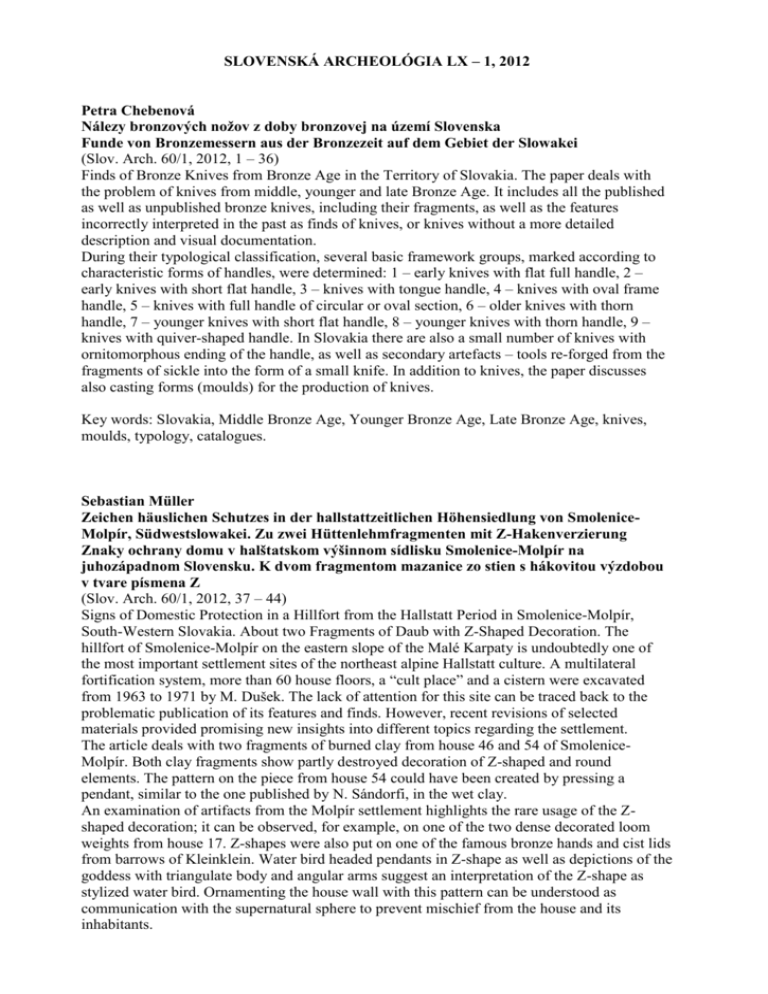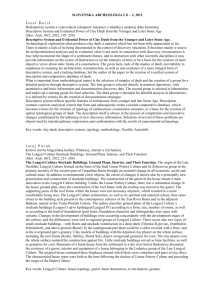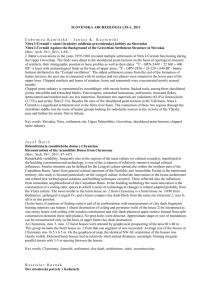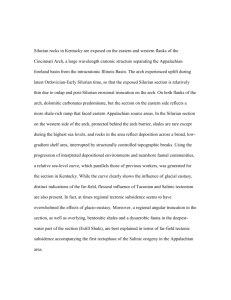SLOVENSKÁ ARCHEOLÓGIA LIX-1, 2011
advertisement

SLOVENSKÁ ARCHEOLÓGIA LX – 1, 2012 Petra Chebenová Nálezy bronzových nožov z doby bronzovej na území Slovenska Funde von Bronzemessern aus der Bronzezeit auf dem Gebiet der Slowakei (Slov. Arch. 60/1, 2012, 1 – 36) Finds of Bronze Knives from Bronze Age in the Territory of Slovakia. The paper deals with the problem of knives from middle, younger and late Bronze Age. It includes all the published as well as unpublished bronze knives, including their fragments, as well as the features incorrectly interpreted in the past as finds of knives, or knives without a more detailed description and visual documentation. During their typological classification, several basic framework groups, marked according to characteristic forms of handles, were determined: 1 – early knives with flat full handle, 2 – early knives with short flat handle, 3 – knives with tongue handle, 4 – knives with oval frame handle, 5 – knives with full handle of circular or oval section, 6 – older knives with thorn handle, 7 – younger knives with short flat handle, 8 – younger knives with thorn handle, 9 – knives with quiver-shaped handle. In Slovakia there are also a small number of knives with ornitomorphous ending of the handle, as well as secondary artefacts – tools re-forged from the fragments of sickle into the form of a small knife. In addition to knives, the paper discusses also casting forms (moulds) for the production of knives. Key words: Slovakia, Middle Bronze Age, Younger Bronze Age, Late Bronze Age, knives, moulds, typology, catalogues. Sebastian Müller Zeichen häuslichen Schutzes in der hallstattzeitlichen Höhensiedlung von SmoleniceMolpír, Südwestslowakei. Zu zwei Hüttenlehmfragmenten mit Z-Hakenverzierung Znaky ochrany domu v halštatskom výšinnom sídlisku Smolenice-Molpír na juhozápadnom Slovensku. K dvom fragmentom mazanice zo stien s hákovitou výzdobou v tvare písmena Z (Slov. Arch. 60/1, 2012, 37 – 44) Signs of Domestic Protection in a Hillfort from the Hallstatt Period in Smolenice-Molpír, South-Western Slovakia. About two Fragments of Daub with Z-Shaped Decoration. The hillfort of Smolenice-Molpír on the eastern slope of the Malé Karpaty is undoubtedly one of the most important settlement sites of the northeast alpine Hallstatt culture. A multilateral fortification system, more than 60 house floors, a “cult place” and a cistern were excavated from 1963 to 1971 by M. Dušek. The lack of attention for this site can be traced back to the problematic publication of its features and finds. However, recent revisions of selected materials provided promising new insights into different topics regarding the settlement. The article deals with two fragments of burned clay from house 46 and 54 of SmoleniceMolpír. Both clay fragments show partly destroyed decoration of Z-shaped and round elements. The pattern on the piece from house 54 could have been created by pressing a pendant, similar to the one published by N. Sándorfi, in the wet clay. An examination of artifacts from the Molpír settlement highlights the rare usage of the Zshaped decoration; it can be observed, for example, on one of the two dense decorated loom weights from house 17. Z-shapes were also put on one of the famous bronze hands and cist lids from barrows of Kleinklein. Water bird headed pendants in Z-shape as well as depictions of the goddess with triangulate body and angular arms suggest an interpretation of the Z-shape as stylized water bird. Ornamenting the house wall with this pattern can be understood as communication with the supernatural sphere to prevent mischief from the house and its inhabitants. Key words: Smolenice-Molpír, southwest Slovakia, north-eastern Hallstatt culture, Z-shaped decoration, water bird, domestic protection. Veronika Plachá – Denisa Divileková Cintorín z 11. – 12. storočia na hrade Devín Friedhof aus dem 11. – 12. Jahrhundert auf der Burg Devín (Slov. Arch. 60/1, 2012, 45 – 118) Cemetery from the 11th – 12th Centuries at Devín Castle. The presentation of results of archaeological research of cemetery from the 11th – 12th centuries on the south-eastern hillock of the Devín castle. The first research was carried out here by I. L. Červinka (in 1921), and continued by J. Eisner (from 1933 to 1937), and later by V. Plachá and J. Hlavicová (from 1980 to 1987). During the explorations over 600 graves were unearthed, with the prevailing EW orientation. Above some graves stone grave boards were found. Inventory consisted mainly of jewellery and parts of clothing. Some graves could be dated through finds of coins (Ladislas I., Koloman, Solomon). Jewellery was dominated by the s-shaped earrings, mostly massive, in some case with longitudinally ribbed loop. Another type consisted of rings – simple rings made of wire, of stick, stripped, as well as earrings with a plate, eye and with dug out decoration in the form of signs. Four graves contained necklaces from corals made of precious stones (fluorite, carnelian), as well as amber and glass corals. The preserved parts of clothing included buckles from a belt of a circular shape. In three graves iron knives were found. In a grave of the squatted from the beginning of the 13th century there was also a ceramic vessel containing animal bones, and one incomplete vessel also coming from a grave from the second half of the 10th century. Both graves were situated outside cemetery. Stone foundations of a rotund, probably built in the 11th century, were unearthed in the cemetery. The 13th century saw burials already at the Church of St. Cross in a town of Devín, whose oldest core is dated to the mid-13th century. Key words: Slovakia, Devín Castle, cemetery, 11th – 12th, rotund. Radoslav Beňuš – Soňa Masnicová Antropologická, paleodemografická a paleopatologická analýza historickej populácie z hradu Devín Anthropological, Paleodemographical and Paleopathological Analysis of Historical Population from Castle Devín (Slov. Arch. 60/1, 2012, 119 – 156) In total, 210 individuals from the 11th – 12th centuries were analysed, 81 individuals were younger than 20 years, with medium life expectancy determined at 22.0 years, sex was determined in 124 cases (57 men, 67 women). According to anthropometrical characteristics the individuals of both sexes were mesocephalic, body height reaching 167.4 cm for men and 160.4 for women. Of paleopathological lesions, traumatic and developmental lesions were observed, manifestations of physical stress, metabolic diseases (osteoporosis), diseases of teeth and periodontium, neoplastic lesions and manifestations of unspecific stress (cribra orbitalia, hypoplasia of tooth enamel, inflammatory changes in paranasal sinuses). All in all, in case of 25.2 % of individuals at least one traumatic lesion was found. Most numerous occurrences included Schmorl´s nodes, fractures of ribs and ferearm bones. Manifestations of interpersonal violence were found only in the case of 8 men. Women had 19.5 % of impression fractures on skull. Based on the analysis of degenerative-productive lesions (osteoarthrosis, spondylosis), enthezopathiae and traumatic lesions, men from this site were involved mainly in agriculture, though there were also craftsmen and soldiers. Women were engaged in heavy manual work in agriculture and domestic works. Condition of teeth, characterised by the intensity of cariosity (I-CE of men 21.7 %; women 30.7 %) and frequency of cariosity (F-CE of men 84.3 %; women 97.5 %), is not markedly different from populations of similar dating in central Europe. Of paleopathological markers of unspecific stress, there were observed cribra orbitalia (25.8 % in the whole population; 28.3 % in non-adult individuals), hypoplasia of tooth enamel (27.5 % in adult population; 11.4 % in non-adult individuals), and inflammatory processes in paranasal sinuses (14.3 % of population). As for the developmental defects, there was most frequent occurrence of spina bifida occulta (23.9 %), and in one individual the congenital luxation in hip joint. Tumour diseases were most often represented by benign (“button”) osteoma found in six individuals. In case of one adult woman lesions were identified on the left pelvic bone, probably caused by carcinoid of endocrine cells in large intestine. Five women had significantly decreased values of the amount of cortical as well as trabecular bone, and one of them displayed values of marked osteoporosis. Key words: Slovakia, 11th – 12th centuries, osteology, paleopathology, paleoepidemiology, paleodemography, traumatic lesion, infectious diseases, stress, osteoporosis. Miloš Gregor – Ľubomír Vančo – Magdaléna Kadlečíková Mineralogické štúdium korálikov z cintorína z 11. – 12. storočia z hradu Devín Mineralogische Untersuchung der Perlen vom Friedhof aus dem 11. – 12. Jahrhundert der Burg Devín (Slov. Arch. 60/1, 2012, 157 – 168) Mineralogical Study of Beads from the 11th – 12th Century Cemetery at Devín Castle. Beads from the 11th and 12th century cemetery at Bratislava´s Devín Castle were analysed with help of the X-ray diffraction analysis with Goebel mirror and Raman spectroscopy. Orange-red and violet beads, sometimes in older literature marked as amethyst beads, were selected for the study. Mineralogical composition of individual beads was determined according to macroscopic signs and experimentally obtained data. While violet beads are made from fluorite, the orange-red ones are made from carnelian. The fluorite as well as carnelian beads are imported, since fluorite and carnelian do not occur in Slovakia in sufficient quality. Based on the distribution of deposits with the occurrence of fluorite and fluorite beads it may be expected that the raw material comes from Germany, Austria or Bohemia. As far as carnelian is concerned, because of the missing data about a detailed mineralogical and chemical composition of beads and potential raw materials, it is not possible to determine the provenance of raw materials used for their production. Key words: Slovakia, High Middle Ages, fluorite, carnelian, beads, x-ray diffraction analysis, Raman spectroscopy. In memoriam Jozef Bátora: Za docentom Jozefom Hoššom (Slov. Arch. 60/1, 2012, 169 – 170) Alexander T. Ruttkay: Spomienka na doc. PhDr. Miroslava Richtera, DrSc. (Slov. Arch. 60/1, 2012, 171 – 172) Správy Ladislav Olexa: Čin hoden nasledovania – Archeologický skanzen Karpacka Troja (Slov. Arch. 60/1, 2012, 173 – 174) Róbert Ölvecky: VII. protohistorická konferencia „Sociální stratifikace protohistorických komunit na základě výpovědi archeologických pramenů“ (Slov. Arch. 60/1, 2012, 175 – 178) Matej Ruttkay: Zasadnutie výboru Európskej archeologickej rady (EAC – Europae Archaeologiae Consilium) v Bratislave (Slov. Arch. 60/1, 2012, 178 – 179) Milan Hanuliak: Konferencia Archeologie & Antropologie (Slov. Arch. 60/1, 2012, 180 – 181) Recenzie Róbert Bača: Zdeňka Nerudová – Karel Valoch: Moravany nad Váhom. Katalog paleolitických industrií z výzkumu prof. Karla Absolona (Slov. Arch. 60/1, 2012, 183 – 184) Ivan Cheben: Jan Trenner: Untersuchungen zu den sogenannten Hausmodellen des Neolithikums und Chalkolithikums in Südosteuropa (Slov. Arch. 60/1, 2012, 184 – 186) Vladimír Mitáš: Christine Bockisch-Bräuer: Die Gesellschaft der Spätbronze- und Urnenfelderzeit im „Spiegel“ ihrer Bestattungen. Eine Untersuchung am Beispiel Nordbayerns (Slov. Arch. 60/1, 2012, 187 – 189) Noémi Pažinová: Franz Pieler: Die Bandkeramik im Horner Becken (Niederösterreich): Studien zur Struktur einer frühneolithischen Siedlungskammer (Slov. Arch. 60/1, 2012, 190 – 192)






